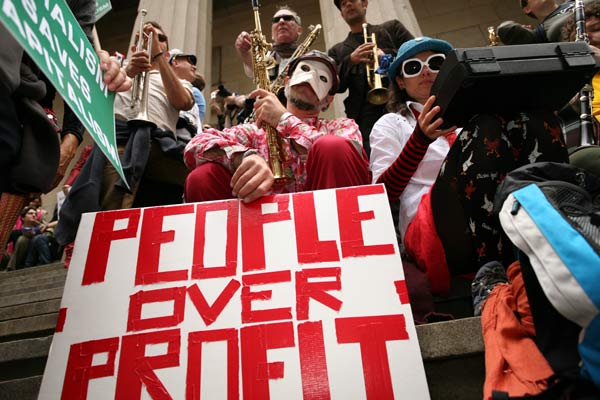The news this week has exploded with round-the-clock media coverage of the Wall Street protests now thought to include over 5,000 protesters, a political event which has failed to grasp the headlines in earlier weeks despite its rolling action. The Guardian ran a series of in-pictures after the beginning of the movement on September 18th, yet previous activism was left undiscovered in mainstream news. Now however, the Wall Street Movement is spreading; from hundreds flocking to Bushnell Park in Connecticut and the growing encampment in Los Angeles, to Canada and abroad, our fury at the western empire which has forced us onto the streets continues to be realised.
There’s a danger facing this movement however. Are the actions of protesters and occupiers undermined by a strand of left-wing populism (a matter some have disputed) which is snaking its way throughout the rallies? While media attention and popularity is of course crucial to the notable success of the movement, are the economic and political inadequacies of Wall Street and western government being taught to the youngsters who are remonstrating? Arguably, detailed knowledge is not necessarily a requisite, in favour of awareness of the overall cause, and with the Internet offering such widespread information on the reasons behind sit-ins and assemblies, protesters can attain information much more easily. Yet the movement has to be aware of its status at all times, reaffirming its pathway from Wall Street, the very giant which led to the corporate control of democratic America.
Fortunately, the movement only has to deal with minor political quibbles from the likes of Republican presidential candidate Herman Cain who claimed that protesters ‘should go figure out what America is all about’. Of course, their anger is pointed squarely in the face of the commercial administration that has undermined the rights of the American people. Reinforced by support from unions and public organisations, including online solidarity in the form of support groups and political hacktivists, the push can be made towards European market easing, pressuring the policymakers to tighten up on bank control.
There’s also public sympathy which spreads with far-reaching solidarity. Compassion from local law enforcements juxtaposed with the staggering amount of illicit and disproportionate arrests made creates a confusing narrative, suggesting government control and influence over how demonstrators are handled. This then has to be clarified by right-wing news agencies, which are already battling against the dominant left-wing support. The whole thing allows for an objective assessment of the protests, an understanding which stems from the social positions that the majority find themselves in.
The country finds itself divided, and if at the least, this movement harbours the unity and solidarity required in times of hardship and oppression. Making its way throughout the country and overseas, it’s crucial that it doesn’t let up, continuing its plea for online support on the likes of YouTube, Twitter and Facebook, all of which have such a huge role in mobilisation and reportage. Recently summed up in the Washington Post, what’s driving this movement is unhappiness, an emotion which can give birth to the most effective forms of protest.
